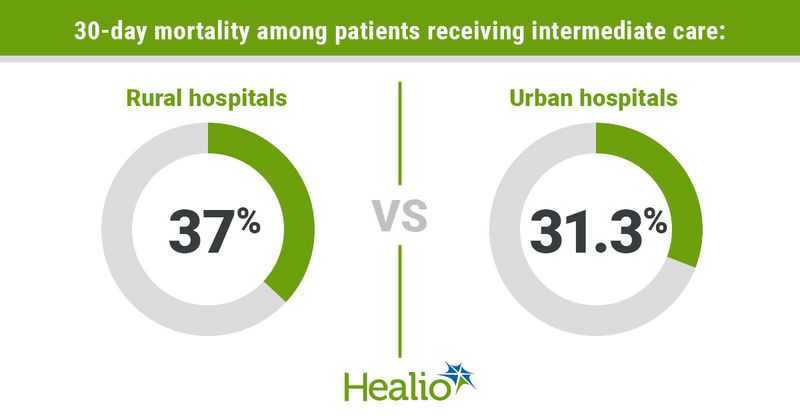Mortality rates of mechanically ventilated patients high in rural intermediate care
Key takeaways:
- Thirty-day mortality among mechanically ventilated patients significantly differed based on rural vs. urban intermediate care.
- In contrast, mortality was similar in rural and urban ICUs.
A higher percentage of older adults receiving invasive mechanical ventilation in intermediate care units died by day 30 in rural vs. urban hospitals, according to results published in Annals of the American Thoracic Society.

“Intermediate care does not use as many resources, such as nurses, compared to an ICU, but patients receive more nursing care and monitoring compared to a regular hospital room,” Emily A. Harlan, MD, MA, pulmonary and critical care physician at University of Michigan, Ann Arbor, told Healio. “Because intermediate care uses fewer resources than an ICU, it is thought to be less expensive compared to the ICU.”

In this study, Harlan and colleagues assessed 2,752,492 hospitalizations of mechanically ventilated Medicare beneficiaries aged 65 years or older between 2010 and 2019 to determine how 30-day mortality differs based on the type of care patients received in rural vs. urban hospitals.
A small percentage of the assessed hospitalizations took place in rural hospitals (7%).
Researchers found that most of the hospitalizations in both rural and urban hospitals involved care in the ICU (89.5% vs. 84.7%), with fewer hospitalizations involving intermediate care (5.4% vs. 10.3%) or general care (5.1% vs. 5%).
Following adjustment for age, sex, deprivation index, primary diagnosis, illness severity, year, comorbidities and hospital volume, researchers did not find a significant difference in 30-day mortality between ICUs in rural hospitals and ICUs in urban hospitals (both 46.7%).
“A common belief is that rural hospitals may provide worse quality of care than urban hospitals, but we found that older patients with respiratory failure needing ventilator life support in rural ICUs were just as likely to survive as patients in urban ICUs,” Harlan told Healio.
“Rural ICUs are taking care of severely ill patients, and continued investment in rural hospitals is essential to ensure people living in rural areas have access to high quality, potentially life-saving care,” Harlan continued.
Researchers further found no significant difference in mortality among patients receiving general care in rural (63.6%) vs. urban (64.4%) hospitals.
This outcome did not recur in the assessment of mortality rates in intermediate care units. Among those receiving intermediate care, significantly more patients in rural vs. urban hospitals died by day 30 (37% vs. 31.3%).
This outcome continued to be seen in several additional analyses, including one that only included intermediate care hospitalizations with maximum lengths of stay of 30 days, one that did not include patients who received noninvasive ventilation and one that factored out transfer patients.
“Since we found that patients in rural intermediate care units were more likely to die than their urban counterparts, I would underscore that we should carefully consider which patients receive care in intermediate care units,” Harlan told Healio. “This study suggests that the ICU may be the best place to care for patients with respiratory failure requiring ventilator life support in rural hospitals.”
Between 2010 and 2019 in rural hospitals, intermediate care admissions rose (4.1% to 6.3%), whereas ICU admissions fell (90.8% to 88.4%).
In contrast, researchers noted that these admissions stayed relatively the same over the years in urban hospitals.
“We should learn more about the care that is being provided in intermediate care units across the U.S. to understand how to optimize use of this level of care,” Harlan told Healio.
Reference:
- NIH study shows higher mortality rates for patients on respiratory support in rural intermediate care units. https://www.nih.gov/news-events/news-releases/nih-study-shows-higher-mortality-rates-patients-respiratory-support-rural-intermediate-care-units. Published Jan. 31, 2024. Accessed Jan. 31, 2024.
